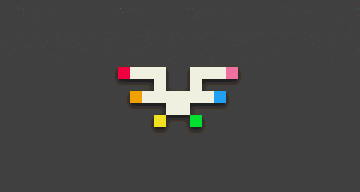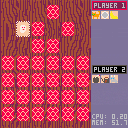Making a city generator. This generates a city from a selection of buildings chosen at random. Each city block includes animations of such things as people walking around. There are tall buildings, short hotels, parks, bicycle stops, and empty spaces like a field. There are buildings getting built and others that are deteriorating.


This is a 2-player version the classic memory card game, Concentration. Players take turns flipping cards over two at a time. When a match is found, the player claims the cards and takes another turn. Flipping over two cards that do not match results in the other player taking a turn. Whoever has the most cards by the time all have been claimed wins.
This game is fully playable. I started working on it while teaching my 4 year old how to play with physical cards.
Only arrow keys and the 'X' button are used.
This is a Pico-8 implementation of the classic memory card game, Concentration. Players take turns flipping cards over two at a time. When a match is found, the player claims the cards and goes again. Flipping over two cards that do not match results in the other player taking a turn. Whoever has the most cards by the time all have been claimed wins.
This game is fully playable. I started working on it while teaching my 4 year old how to play with physical cards.
Only arrow keys and the 'X' button are used.
Version History:
- 0.2
- wood grain background
- intelligent positioning of popups
- winner is declared at end
- more cards

I'm working on the classic memory matching card game, Concentration. My work-in-progress is below, but I have a beginner question regarding best practices when coding on the Pico-8.
The grid of cards is currently maintained using a 2D Lua table with each cell containing a few properties such as the picture to display and whether it's flipped or not. This is working well enough, but... I could just as easily store the card faces in the Pico-8's map data. The same goes for the collection of cards collected by each player. In fact, this game doesn't need to store any values greater than can be fit into 8 bits so I could potentially store all data this way. I'd simply be exchanging Lua table lookups with memory reads and writes.
I guess my question to more experienced coders is whether leaning on Lua data structures or Pico-8 memory structures is preferred? I don't expect that there is one simple answer to that, but are there pros and cons I might not be aware of after having read through the manual a few times?










 0 comments
0 comments

